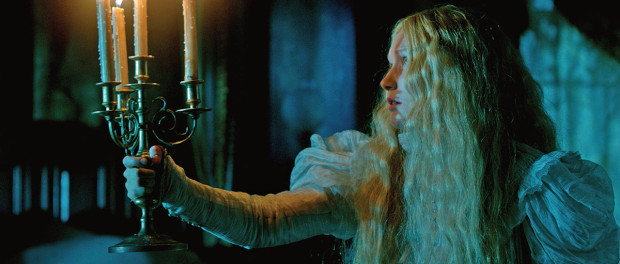Crimson Peak Delivers an Eerie, Gothic Atmosphere
I am not the greatest fan of gothic horror flicks. I enjoy a good Hitchcock film, but my taste remains confined to the classics. When I looked through the trailers of Crimson Peak, I was intrigued. The gore and the horror seem passable, while the acting talents of Mia Wasikowska, Tom Hiddleston and Jessica Chastain were extremely attractive. I decided, why not?
Guillermo del Toro (from the famed Pan’s Labyrinth) has come up with a gothic horror romance that’s deeply rooted in incest and family tragedy. But the fundamental problem with the film is the non-revelation of this principle element of the film that, for the longest time, pretty much drives two of the three protagonists through the film. Until about the late second half of the film, I was constantly telling myself, it’s about the money – Thomas Sharpe (Hiddleston) and his sister Lucille (Chastain) are after the money. While hints of sibling possessiveness and protective eccentricity were palpable, they were never unraveled to the depths of what was to be uncovered at the end of the film.
Del Toro created a visually stunning, authentic, and classy world in Crimson Peak, where an inventor, traveller, and high-class British noble Thomas travels to the United States to try and find investors for his clay drilling invention/machine. He has apparently been around Europe courting moneybags, but finally landed on North America’s shores to try his luck. He meets Carter Cushing (actor Jim Beaver) who is Edith’s (Mia Wasikowska) father. Cushing instantly becomes suspicious of the lad and his sister (Lucille) accompanying him, marching off a detective to look into his/their past. What is unearthed warrants that Thomas is paid off a handsome sum of money, for Edith is increasingly taken by the high-class British gentleman and Thomas plays it to the hilt.
Next scene and Cushing is brutally murdered and Edith is on her way to the moors of England, where she is to inhabit this completely disconnected gothic mansion, where the local town is half a day’s walk away. As a young heiress to her father’s fortune, the brother-sister duo have their eyes and hands on her.
The world Del Toro has created in Crimson Peak is marvelously enchanting and somewhat spooky. I can’t call it horror or scary, because all of the ghosts seem like plasticized versions of the famous Body Worlds exhibit that came around a few years ago. They represent tragedy in the family, murder and blood, but never authentically connect enough to garner sympathy.
Edith soon discovers that the gothic house has stories and a dark history (surprise surprise). While Thomas seems to be wanting to break away from his sister and is slowly falling in love with his new wife, Lucille continues to become more anxious and suspicious of the young and beautiful entrant to the household. As Edith discovers more and more of the secrets of the house and the family, the brother-sister relationship comes to a head and Edith’s life becomes more endangered.
Through this romantic, gothic drama, Del Toro uses the symbolism of the clay mines, over which the house is built. They seep red into the snow all winter, creating the crimson earth that surrounds the house. While all the elements of a sound and compelling gothic horror tragedy are there, Crimson Peak failed to engage and left me wondering why the real heart of the story remained wrapped in the peripheral beauty of the house. The music remained creaky and included shrieks of the ghosts and not much else. One of the few delightful moments of the film was when acting powerhouse Jessica Chastain was really given the chance to act and excel. She confronts both Edith for her fear of losing everything she holds dear and in the same vein tries to unravel the demons of her childhood that made her the way she is.
Watch it if you have time on a fall afternoon and enjoy Wuthering Heights-style stories with easterly winds and eerie houses on moors.
Crimson Peak is now playing in theatres.








